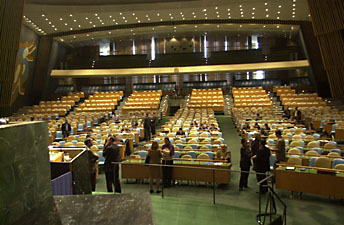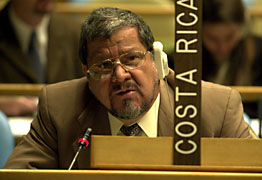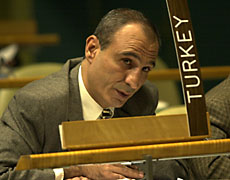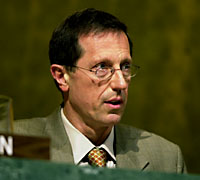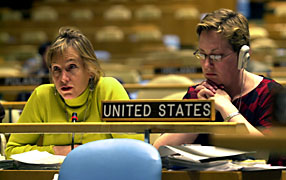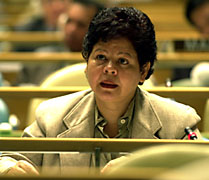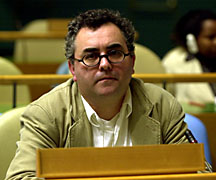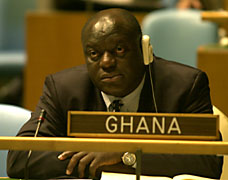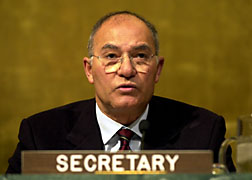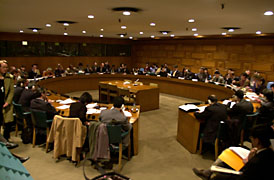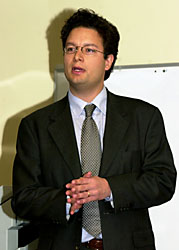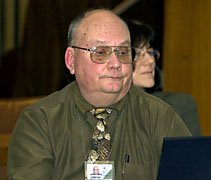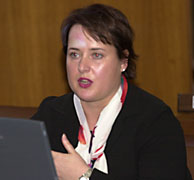 |
UNFF-2:
Second
Session of the United Nations Forum on Forests
UN Headquarters || 4-15 March 2002 |
|
|
Day 5: Friday, 8 March In the General Assembly Hall, Working Group I spent the day discussing low forest cover countries, (LFCCs); rehabilitation and restoration of degraded lands and promotion of natural and planted forests; enhanced cooperation and policy and programme coordination; and proposed revisions to the medium-term plan for 2002-2005. Informal consultations were held on preparations for the high-level ministerial segment. Photo, above right: there was some confusion on Friday morning as delegates tried to figure out which group would be meeting in which room... |
|
|
|
Side event: What can forestry mean for the WTO?
In a side event hosted by the World Trade Organization, Erik Wijkström, WTO Trade and Environment Division (right), offered UNFF-2 some general remarks on how forestry may be relevant to the WTO, noting in particular how forest issues might fit within the WTO framework. He also outlined the environmental references in the recent WTO Doha Ministerial Declaration. To begin, Wijkström stressed that the WTO is a member-driven organization and that WTO membership has not made forestry a priority issue as yet. He said that with the exception of tariff peaks and escalations, forest products encounter relatively low border tariffs. On the question of subsidies, Wijkström mentioned that forestry subsidies per se have not been an issue at the WTO. He did mention, however, the current WTO dispute between CANADA and the US over the unilateral application of US trade remedy law against Canadian softwood lumber. In this case, Canada alleges that the application of US trade remedy law against its softwood lumber imports contravenes the WTO rules. The US justifies the levy on the grounds that Canada is subsidizing forest production through its forest management regime. Following this discussion, Wijkström highlighted a recent upward trend in the use of the Agreement on Sanitary and Phytosanitary Measures (SPS) and the Technical Barriers to Trade Agreement (TBT) following a general reduction of tariffs and subsidies. He then explained how each agreement may affect the trade in forest products. Of particular relevance to the UNFF discussion is the question of forest product certification and eco-labelling more generally. As it stands, the WTO rules remain ambiguous on the issue of eco-labelling, or non-product PPMs (non-product related process and production methods). Wijkström finished his presentation with a brief description of the environmental references in the Doha Declaration (a Ministerial decision reached at the WTO's most recent Ministerial Conference in Doha, Qatar in November 2001 which formally launched a new round of multilateral trade negotiations). He noted five specific references: - A reference
to sustainable development in the Declaration chapeau (paragraph 6); The ensuing discussion focused mainly on logistical matters pertaining to external transparency and NGO participation at the WTO. |
|
Side
event: Forest Terminology & Definitions: Ongoing Activities
of IUFRO, FAO and CIFOR
Renata Pruller, Coordinator of IUFRO's Terminology Project (right), described the Union's SilvaVoc clearinghouse project on multilingual forest terminology. She discussed some of the terminology problems facing the forestry sector, such as the variety of definitions, the changing nature of concepts, the use of English as the lingua franca of science and the problems this presents for non-native speakers, the constant creation of new terms (neologisms) and the varying audiences that attempt to use the same terms. She said the SilvaVoc project united over 15,000 forest experts into working units, and she highlighted the "6.03.02 - trends in forest terminology" group. She invited all to visit SilvaVoc's multilingual website (http://iufro.boku.ac.at/iufro/silvavoc/), and highlighted its bibliography section and the SilvaTerm online database.
He described the work of the "6.03.02 - trends in forest terminology" group, and concluded by saying there was a need for consistent use of terminology in the forest sector especially at the international level.
- selection of a few priority terms and concepts - arrangement in a matrix - comparison and analysis of differences - adaptation for convergence, if feasible - harmonization The conclusions of the meeting were: that harmonization reduces reporting burden, that existing definitions should be used and adjusted if feasible instead of creating new ones, and that the definitions used in Global Forestry Resource Assessment 2000 and in the Kyoto are largely compatible with the exception of "reforestation". She said that the second experts meeting on harmonizing forest-related definitions will be held in August 2002 and will submit its results to relevant international bodies and fora. John Poulsen, CIFOR, described an ongoing informal discussion entitled "A typology of planted forests". He said that inconsistencies in categories definitions and in reporting can mask differences in quality and quantity of tree cover. He noted the socio-economic and ecological implication of different types of tree covers and stated that not all planted forests are plantations. He then presented a proposed typology for planations (please refer to CIFOR website for the document). For more
information: |
